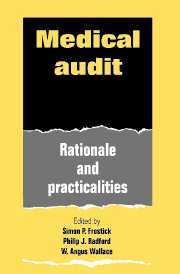Book contents
- Frontmatter
- Contents
- List of contributors
- Foreword
- Foreword
- 1 Introduction
- 2 Audit: historical and future perspectives
- 3 Audit philosophy
- 4 Medical audit: a view from the centre
- 5 Audit: a view from the Royal College of Surgeons of England
- 6 The regional viewpoint
- 7 Medical audit: the needs of the District Health Authorities
- 8 Resource management and budget holding
- 9 Unit and district information systems
- 10 Read codes and medical audit
- 11 Data capture direct from doctors
- 12 Computer systems: practice, limitations and pitfalls
- 13 Paediatric audit
- 14 Audit in obstetrics and gynaecology
- 15 Audit in general surgery
- 16 Orthopaedic audit: guidelines and hints
- 17 Installing audit in general practice and general dental practice
- 18 Clinical audit in psychiatry. Models for audit in mental health
- 19 Audit in anaesthesia
- 20 Audit in intensive care
- 21 Medical audit: lessons from the USA
- 22 Quality control in health care: the Dutch experience
- 23 Medical audit: experience from Sweden
- 24 Performance indicators
- 25 Measuring outcome and quality control
- 26 Audit: will it work?
- 27 What has been achieved so far?
- 28 A practical guide to audit
- Index
15 - Audit in general surgery
Published online by Cambridge University Press: 30 September 2009
- Frontmatter
- Contents
- List of contributors
- Foreword
- Foreword
- 1 Introduction
- 2 Audit: historical and future perspectives
- 3 Audit philosophy
- 4 Medical audit: a view from the centre
- 5 Audit: a view from the Royal College of Surgeons of England
- 6 The regional viewpoint
- 7 Medical audit: the needs of the District Health Authorities
- 8 Resource management and budget holding
- 9 Unit and district information systems
- 10 Read codes and medical audit
- 11 Data capture direct from doctors
- 12 Computer systems: practice, limitations and pitfalls
- 13 Paediatric audit
- 14 Audit in obstetrics and gynaecology
- 15 Audit in general surgery
- 16 Orthopaedic audit: guidelines and hints
- 17 Installing audit in general practice and general dental practice
- 18 Clinical audit in psychiatry. Models for audit in mental health
- 19 Audit in anaesthesia
- 20 Audit in intensive care
- 21 Medical audit: lessons from the USA
- 22 Quality control in health care: the Dutch experience
- 23 Medical audit: experience from Sweden
- 24 Performance indicators
- 25 Measuring outcome and quality control
- 26 Audit: will it work?
- 27 What has been achieved so far?
- 28 A practical guide to audit
- Index
Summary
Introduction
Each surgeon treats his own patients as he thinks best. The time honoured concept of clinical freedom must today be balanced by contemporary demands for accountability and value for money.
The argument that critical assessment of our work is part of the surgical ethic and anyway built into our professional lives, is powerful but no longer good enough. All of us want to make the best use of our time, and the vast majority would honestly wish for accurate information about the appropriateness of our surgical endeavours. The aims of abolishing the unnecessary, while treating the patients with the minimum morbidity and maximum satisfaction are right and proper. Audit is the cornerstone of these endeavours. It should, therefore, become an integral part of surgical practice, just as much as ward rounds, out-patient clinics and operating lists.
It is fashionable to divide audit into three components: structure, process and outcome. This may be helpful administratively but less so clinically, since undue emphasis is placed on the audit of structure and process and outcome is neglected.
Since doctors are responsible for nearly all spending on health care, they need to ensure that resources are used wisely by administrators and politicians as well as by themselves.
- Type
- Chapter
- Information
- Medical Audit , pp. 201 - 222Publisher: Cambridge University PressPrint publication year: 1993

